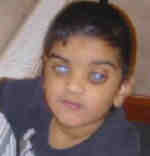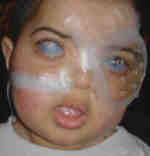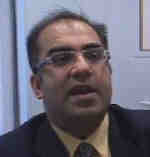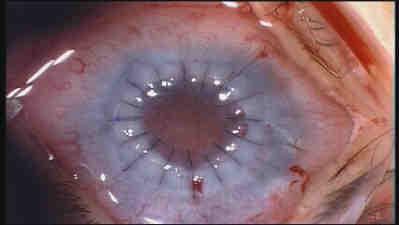Sandip and Jaydip Bhattacharyya
Peter's Anomaly

Sandip

Jaydip
Southall, West London is home to two brothers, Sandip and Jaydip Bhattacharyya. Sandip is four and Jaydip is eighteen months old. Both were born virtually blind with the same deformity of the cornea a condition known as Peter's Anomaly. The cornea is the front part of th eye that is normally clear, but in Sandip's and Jaydip's case it is severely clouded. Both are on the waiting list for a cornea transplant that could transform their lives. Ken Nischal is one of a handful of eye surgeons willing to perform cornea transplants on very young children.
He believes that if he can restore even partial vision at an early age, the child's brain has a better chance of developing to process the visual signals.
It was a shock for his parents, Ranjit and Dilip, when Sandip was born with such poor sight and an even greater blow when Jaydip arrived, two and a half years later, with even worse problems. Although Jaydip's problems were worse than his brother, he was lucky in being quickly diagnosed at Great Ormond Street. Ken Nischal was able to perform a cornea transplant on one eye, a year ago when Jaydip was just six months old.

Ken Nischal
The consultant ophthalmic surgeon explains the urgency "When I first saw Jaydip, because he was bilaterally affected, it was crucial that we managed to do one eye as quickly as possible. The fact that his one eye was given clarity means that his brain has developed the ability, at least in that eye, to develop full vision".
At four years old, help has come very late for Sandip. He has some learning difficulties, but improved vision could give him the extra stimulation and confidence he needs. A cornea transplant is a high-risk procedure and the worst case scenario could lead to the loss of the eye.
The donor cornea has to come from someone under the age of eighteen and they need to be ready to go into hospital at 24 hours notice.
Sandip and Jaydip need such intensive care that their parents are unable to look after both of them. Sandip live with mum and dad, while Jaydip lives with family friends. Both children need to have eye-drops administered throughout the day. Jaydip also has digestive problems and has to be fed using a tube and a feeding machine to ensure that he maintains weight in case he gets the transplant or needs emergency surgery.
After nearly a year, two donated corneas, that are suitable for Sandip and Jaydip, have become available at the Bristol Eye Hospital. They are sent to Great Ormond Street and the family are told to prepare for an operation the next day.
Jaydip is first into surgery. The cornea is the very front part of the eye. It covers the iris and pupil, refracts light and helps the eye focus. It takes Mr Nischal over two hours to remove Jaydip's clouded cornea and stitch the replacement into place. Mr Nischal explains that Sandip's operation will be technically more difficult, as he is older and the eye is bigger. One of Ken Nischal's innovative techniques is the use of ultrasound to check the structure and condition of the eye before surgery.

Stitched, Transplanted Cornea
Next day, Sandip and Jaydip are almost ready to go home. The stitches will be removed in three months time when the corneas have grafted into place. The boys will always have poor vision, but the transplants have given them better vision than they had.
Six days later, Ranjit rushed Jaydip back to Great Ormond Street, his eye has started bleeding. This is bad news and the prognosis for the eye is poor. When Mr Nischal gets him to theatre, he finds that five of the stitches have ruptured, but, to his surprise, the lens is still in place and the eye looks fine.
Three months on and Jaydip has suffered no further complication from the bleeding.
Both boys have seen significant improvements in their vision, and consequently their educational development.
NB: Apologies if the boy's names are Sandeep and Jaydeep.
CREDITS: All of this information came from the UK Channel 5 "Child in a Million" documentary series

